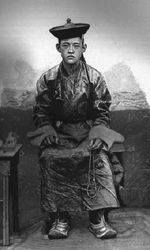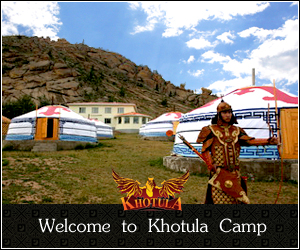Bogd Khan
 With the fall of the Manchu dynasty in 1911, the Mongolians proclaimed their independence in December. Fighting against the Chinese, with some aid from the Russians (which was given belatedly), was to continue until August of 1912. Further fighting was to take place in 1913, but this was in present-day Inner Mongolia, and was part of an attempt to create a pan-Mongol state.
With the fall of the Manchu dynasty in 1911, the Mongolians proclaimed their independence in December. Fighting against the Chinese, with some aid from the Russians (which was given belatedly), was to continue until August of 1912. Further fighting was to take place in 1913, but this was in present-day Inner Mongolia, and was part of an attempt to create a pan-Mongol state.
Indeed, during much of the Bogd Khan (1911-1921) period and even afterwards, there were attempts to include Inner Mongolia (but not, apparently Buriatia) under the new Ar Mongol regime. Bogd Khan braved the might of Chinese rulers to declare independence. While Beijing remained shocked by such impudence from the usually meek Mongols, and the bureaucratic machine was slowly eschewing the news, Bogd Khan liberated the country and announced himself Khan of Mongolia.
The warning from Beijing to stop the “mutiny” did not slowed down Bogd Khan in his far reaching quest for Mongolia’s liberation, including Inner Mongolia as well. In spring of 1913, Mongolian troops defeated the Chinese army on the southern border and advanced to Inner Mongolia, and if were not for the diplomatic demarche of Russian, they would have taken over Beijing. The Russian emissary to Beijing urgently signed an agreement with China, according to which Outer Mongolia was recognized an autonomy and both superpowers consenting not to occupy it. Inner Mongolia, however still remained under the Chinese jurisdiction.
The new state was a theocracy, headed by the Eighth Javzandamba Hutagt (a Tibetan), who was installed on 29 December, 1911, known as the Bogd (Holy) Khan. Thankful Mongols granted the title of All Elevated Khan to 42-year-old Tibetan and presented him 99 white mares and 99 white she-camels according to traditions of Chinggis Khan times. With his ascension to the throne, the (nominal) separation of power into the secular and religious spheres, the dominant political model since the time of Altan Khan, effectively collapsed.
After stepping on throne he allowed to set up a two-chamber parliament replacing the National Council consisting of nobles exclusively. Secular nobles were to be found in the new government, but they remained under the control of the Bogd Khan. He encouraged education and helped to set up a number of non-religious schools. Mongols deeply revered and even loved him.
Bogd Khan came to Mongolia from Tibet at age of five to become the Rebel Monk. His Tibetan name was Luvsanchoijinimadanzinbanchug. Only recently the truth about the life and deeds of Bogdo Khan, the head of the Lamaism religion and the last Khan of Mongols emerges.
For decades the communist powers badmouthed and distorted his image portraying him as an old debauchee, half blind syphilitic and the oppressor of people. But in reality he was the key figure behind the declaration of independence of Mongolia after 200 years of Chinese rule. For his quest of the country’s independence he was named the Rebellious Priest. It was him who ordered in 1911 to arrest the Peking appointed governor and defeated the Chinese garrison taking Manchu rulers by surprise.
He died on April 1924 and was buried with honors inside the Gandan monastry. Few years later the monastery was turned into a barrack for Russian military and his remains disappeared without trace. The Summer Palace of Bogdo Khaan is now a museum.
Source from: www.chriskaplonski.com












